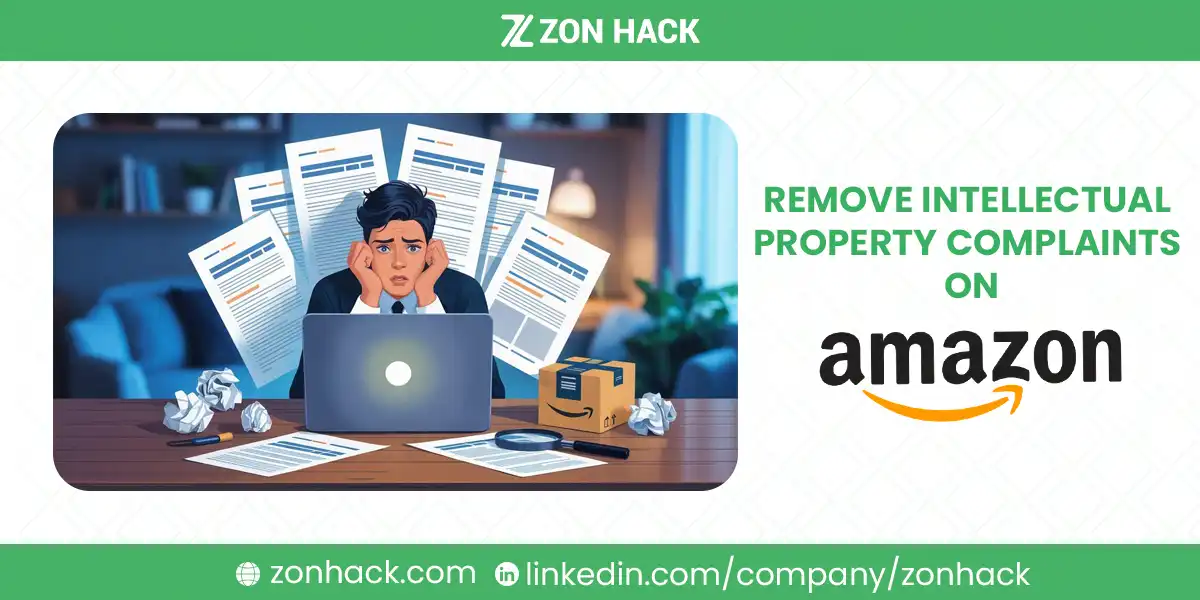An Intellectual Property (IP) complaint on Amazon is a serious issue that can put your entire business at risk.
Amazon takes IP rights seriously. Whether it’s a claim of trademark infringement, copyright violation, patent misuse, or selling counterfeit goods, the platform acts quickly—and often without warning.
Even one IP complaint can trigger an ASIN takedown, freeze your payouts, or worse, lead to account suspension. And if Amazon believes the complaint is valid, they won’t hesitate to ban your account permanently.
There’s a key distinction you need to understand early on:
- A “suspected” IP complaint means Amazon’s system has flagged your listing as potentially infringing.
- A “received” complaint means a brand owner or legal representative has officially reported you.
Both require attention—but received complaints are far more urgent.
Quick Takeaway: One unchecked IP complaint can cripple your store. Know how to respond—or get help fast.
The 4 Most Common Types of IP Complaints on Amazon
Before you can fight back, you need to know what you’re dealing with. Amazon classifies IP complaints into four main categories:
1. Trademark Infringement
This involves the unauthorized use of a brand name, logo, or slogan that’s protected by trademark law. Even mentioning a trademarked term in your listing title or bullet points can trigger a complaint.
Example: Listing headphones with “compatible with Bose®” can raise flags if you’re not authorized.
2. Copyright Infringement
If you’re using product images, written descriptions, or A+ content copied from another source—even a supplier—you could be in violation of copyright law.
Example: Uploading lifestyle images taken from a brand’s website without permission.
3. Patent Infringement
This occurs when you’re selling or importing a product that’s too similar to a patented design or function. It doesn’t matter if you sourced it from a legitimate supplier—if it violates a registered patent, you’re liable.
Example: A yoga wheel with the same design mechanism as a patented competitor.
4. Counterfeit Allegations
These are among the most damaging. Brands can report you for selling fake versions of their products—even if you’re selling authentic items without proper documentation.
And here’s the hard part: Amazon often sides with the rights owner until you prove otherwise.
Why Amazon IP Complaints Happen So Often
Even experienced sellers fall into the trap of assuming good faith and fair judgment on Amazon. But in reality, IP complaints are often driven by competitive pressure, bot-driven enforcement, and documentation errors.
Here’s why they’re so common:
- Using content from suppliers without realizing it’s protected.
- Listing branded products without being officially authorized.
- Buying from gray-market or retail arbitrage sources like Walmart, and failing to retain proper invoices.
- Competing brands filing false claims just to knock your listing down.
- Amazon’s bots flagging listings based on keywords or complaints patterns, even when there’s no real violation.
Quick Tip: Being a legitimate seller doesn’t guarantee protection. Without solid proof and clean listings, you’re always at risk.
Step-by-Step Guide to Remove IP Complaints on Amazon
Step 1: Review the Complaint
Start by logging into Seller Central and navigating to the Account Health dashboard. There, you’ll see flagged ASINs and complaint types.
Take note of:
- The ASIN in question.
- The complainant’s email or contact info.
- The complaint type (e.g., copyright, trademark).
- Any accompanying evidence or messages from Amazon.
The clock is ticking. The sooner you act, the better your chances.
Step 2: Investigate the Validity
Now it’s time to analyze your listing and sourcing:
- Are you using brand terms without permission?
- Are the images original or pulled from the brand’s media kit?
- Do you have proper invoices, supplier documentation, or authorizations?
- Was the product sourced from a marketplace (e.g., eBay or AliExpress) instead of a verified wholesaler?
If it’s a valid complaint, move to corrective action.
If it’s invalid or abusive, prepare to defend your case.
Step 3: Contact the Complainant (If Valid)
If the complaint has merit, you may still be able to resolve it quickly by contacting the rights owner.
Send a polite, professional email requesting a retraction. Be concise and include:
- The case ID and ASIN.
- A brief explanation or apology.
- Proof of corrective steps or authorization.
- A request for the complainant to email Amazon with a retraction.
ZonHack Tip: We handle this entire communication for you—drafting emails, attaching proof, and following up persistently to get results.
Step 4: Take Corrective Action Immediately
If the complaint is valid, Amazon expects quick and meaningful changes.
That means:
- Deleting the listing tied to the complaint.
- Removing inventory from FBA if it’s linked to a trademark or counterfeit issue.
- Cutting ties with shady suppliers.
- Cleaning up product titles, bullets, and backend keywords that misuse brand names.
Sometimes, a partial fix isn’t enough. If Amazon sees signs of a repeat issue, they’ll suspend your account without further notice.
ZonHack Solution:
At ZonHack, we not only help you remove the bad listings but also audit your full catalog, flag risky listings, and clean up your content before another complaint strikes. We’ve resolved over 1,000 ASIN complaints with turnaround times under 48 hours.
Step 5: Draft and Submit a Plan of Action (POA)
Once corrective actions are taken, Amazon typically requires a Plan of Action (POA) before reinstating your listing—or your account.
A successful POA isn’t just an apology. It’s a structured document showing that you understand the issue, took responsibility, and implemented real changes.
Here’s what a winning POA should include:
1. An Acknowledgment
Briefly acknowledge the issue. Don’t argue or deflect. Amazon wants sellers to accept accountability—even if you believe the complaint was exaggerated.
2. Root Cause Analysis
Get specific. Was it unauthorized sourcing? Was it a poorly written listing that used protected brand terms? Vague explanations like “we weren’t aware” will get your POA rejected.
3. Corrective Actions
List what you’ve already done:
- Deleted listings or pulled FBA inventory
- Cut ties with suppliers
- Replaced images or content
4. Preventive Measures
Explain what you’re doing to make sure it never happens again. More on this in the next section.
5. Attachments
This might include:
- Invoices or letters of authorization
- Email communication with the complainant
- Screenshots showing updates made
ZonHack Solution:
Writing a POA is where most sellers fail. ZonHack has a team of appeal experts who craft detailed, Amazon-compliant POAs that are accepted on the first try. Our legal writers understand Amazon’s language—and what triggers auto-rejections.
We’ve handled over 500 POA submissions with a 90%+ success rate.
Step 6: Submit a Counter-Notice (If Invalid or Abusive)
If you’ve investigated and determined the complaint is baseless—or the rights owner never responded to your retraction request—you can file a counter-notice under the Digital Millennium Copyright Act (DMCA).
But be cautious. This route has legal implications and should only be used when:
- You’re certain no IP was infringed.
- The complaint is abusive or false.
- You’ve tried and failed to reach the complainant.
Your counter-notice must include:
- A clear legal statement denying infringement
- Your contact details
- A request for Amazon to reinstate the listing
- Supporting evidence like invoices or original content
If the complainant doesn’t respond within 10–14 business days, Amazon may reinstate your listing.
ZonHack Tip:
We handle counter-notice filings as part of our IP Complaint Defense package—ensuring correct DMCA language, proper documentation, and minimizing risk.
Step 7: Monitor Your Appeal
Once your POA or counter-notice is submitted, monitor your Case Log and Performance Notifications.
Amazon usually replies within 2 to 5 business days, though high-volume periods may delay responses.
If you don’t hear back:
- Follow up on the same case thread
- Submit the POA again (Amazon allows up to three submissions)
Don’t start new cases or bounce between channels. It can reset your appeal status.
Step 8: Escalate or Seek Legal Support
If your case is unresolved after multiple attempts, or if Amazon closes the case without reinstatement, it’s time to escalate.
Here’s how:
- Submit a complaint to Amazon’s Notice Dispute team
- Use the Executive Seller Relations form for internal review
- If needed, pursue legal avenues like cease-and-desist letters or formal litigation
ZonHack has escalated dozens of complaints to Amazon’s senior enforcement teams—and reversed decisions in as little as 72 hours.
How to Prevent IP Complaints in the Future
Avoiding IP complaints altogether is your best defense. Here’s how to safeguard your Amazon business moving forward.
Source Smarter
Work only with authorized wholesalers or brand-approved distributors.
Avoid risky sourcing from Walmart, eBay, Facebook Marketplace, etc.
Always retain:
- Invoices
- Letters of authorization
- Certificates of authenticity (COA)
Do IP Checks Before You List
Before creating a new listing:
- Check the USPTO trademark and patent databases
- Avoid using brand terms or product names unless you’re authorized
Even phrases like “Compatible with X” can be enough to get flagged.
Use Only Original Content
Avoid copying product images, descriptions, or A+ content—even from suppliers.
Create your own listings, images, bullet points, and back-end keywords.
When in doubt, get written permission.
Get Authorized When Needed
If you want to resell a branded product:
- Request a Letter of Authorization from the brand or master distributor
- Enroll in Amazon Brand Registry if you own the IP
ZonHack Advantage:
We offer end-to-end Brand Protection Services—including listing audits, IP checks, custom content creation, and authorized seller documentation. We’ll help you build defensible listings from day one.
Why Choose ZonHack for IP Complaint Removal
Amazon’s system doesn’t give second chances easily—but we do.
Here’s why ZonHack is the go-to partner for IP complaint removal and seller protection:
- Experienced Amazon Appeal Team – With 5+ years of reinstatement success stories
- High Success Rate – Over 90% of POAs accepted on first submission
- Legal Escalation Access – In-house experts and legal teams for severe cases
- Supplier Vetting & Catalog Audits – Find the weak links before Amazon does
- Proactive Monitoring – Ongoing risk alerts and listing hygiene
- Fast Turnaround – 24–48 hour resolution for most ASIN-level issues
Protect your brand. Defend your account. Get back to business—with ZonHack.
FAQs
How long does Amazon take to respond to an appeal or POA?
Amazon usually replies within 2–5 business days, though some complex cases can take longer.
Can I relist the same product after resolving an IP complaint?
Yes—but only if you’ve resolved the root cause and have proper invoices or authorization letters. Don’t relist without fixing the issue.
What if the rights owner never responds to my retraction request?
If you’ve reached out and received no reply, you may file a counter-notice. Make sure it includes all necessary legal statements and proof.
Can ZonHack help if my account is already suspended?
Absolutely. We specialize in account reinstatements, whether it’s due to IP complaints, product authenticity issues, or other violations.
Bottom Line: Get Expert Help Before It’s Too Late
Amazon’s IP enforcement system is cold, automated, and brutally fast. A single flagged ASIN can snowball into a full account suspension overnight.
If you’re reading this because you’ve already received a complaint, don’t waste time with trial and error. Every message you send to Amazon becomes part of your case history—and a weak POA can hurt your chances of reinstatement.
Let ZonHack do what we’ve done for hundreds of sellers:
- Fix the issue
- Reinstate the listings
- Prevent future complaints
Whether it’s one ASIN or a full-blown account takedown, we’ll help you fight back—with precision, speed, and results.




